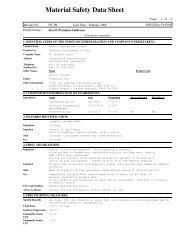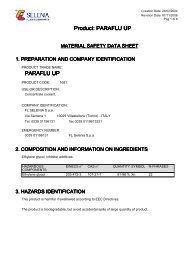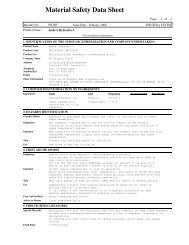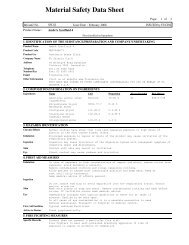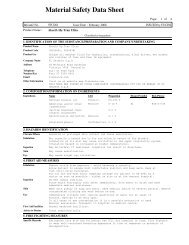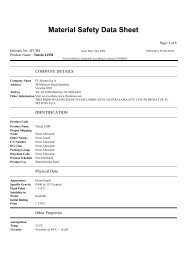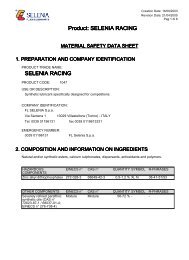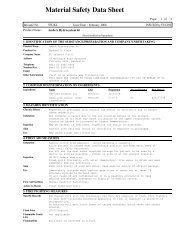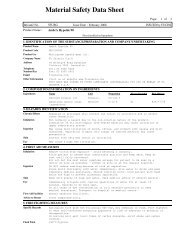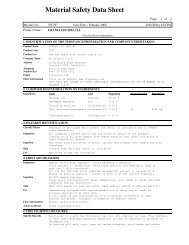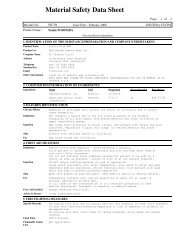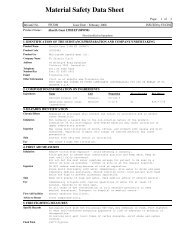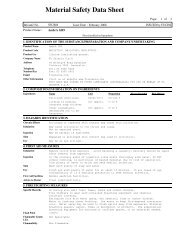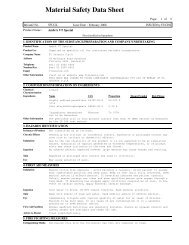AkcelA ATF - FL Selenia
AkcelA ATF - FL Selenia
AkcelA ATF - FL Selenia
Create successful ePaper yourself
Turn your PDF publications into a flip-book with our unique Google optimized e-Paper software.
Material Safety Data Sheet<br />
Page: 1 of<br />
Infosafe No. 5FUF0 Issue Date : February 2008 ISSUED by FUCHS<br />
Product Name :<br />
<strong>AkcelA</strong> <strong>ATF</strong><br />
Not classified as hazardous<br />
1. IDENTIFICATION OF THE SUBSTANCE/PREPARATION AND COMPANY/UNDERTAKING<br />
Product Name<br />
Product Use<br />
Company Name<br />
Address<br />
Telephone<br />
Number/Fax<br />
Email<br />
Other Information<br />
<strong>AkcelA</strong> <strong>ATF</strong><br />
Supplied as a multifunctional automatic transmission fluid for use in suitable<br />
applications only.<br />
<strong>FL</strong> <strong>Selenia</strong> S.p.A<br />
49 McIntyre Road Sunshine<br />
Victoria 3020 Australia<br />
Tel: 03 9300 6400<br />
Fax: 03 9300 6401<br />
flselenia.com<br />
Visit us at website www.flselenia.com<br />
THIS MSDS WAS ISSUED BY FUCHS LUBRICANTS (AUSTRALASIA) PTY LTD ON BEHALF OF <strong>FL</strong><br />
SELENIA S.p.A<br />
2. COMPOSITION/INFORMATION ON INGREDIENTS<br />
Chemical<br />
Characterization<br />
Ingredients<br />
Other Information<br />
Liquid<br />
3. HAZARDS IDENTIFICATION<br />
Irritancy of Product<br />
Chronic Effects<br />
Inhalation<br />
Ingestion<br />
Skin<br />
Eye<br />
4. FIRST AID MEASURES<br />
Inhalation<br />
Ingestion<br />
Skin<br />
Eye<br />
First Aid Facilities<br />
Advice to Doctor<br />
5. FIRE FIGHTING MEASURES<br />
Extinguishing Media<br />
Specific Hazards<br />
Name CAS Proportion Hazard Symbol Risk Phrase<br />
Highly refined paraffinic 64742-56-9 60-100 %<br />
oils<br />
Ingredients determined Mixture To 100%<br />
not to be hazardous<br />
The petroleum oils in this product contain less than 3% DMSO extract as measured<br />
by the IP 346 test method.<br />
Not classified as an irritant.<br />
Generally non-irritant on incidental contact. Excessive or prolonged contact may<br />
give rise to irritant or dermatitic effects.<br />
Due to the low volatility of the product it is not expected to be an inhalation<br />
hazard. Inhalation of vapours generated at elevated temperatures, or of product<br />
mists may cause irritation to the nose and throat.<br />
No adverse effects expected however large amounts may cause nausea and vomiting.<br />
Repeated or prolonged skin contact may lead to irritation.<br />
May cause watering of eyes.<br />
Remove victim from exposure - avoid becoming a casualty. Allow patient to assume<br />
most comfortable position and keep warm. Keep at rest until fully recovered. Seek<br />
medical advice if effects persist. If breathing laboured and patient cyanotic<br />
(blue), ensure airways are clear and have qualified person give oxygen through a<br />
face mask. If breathing has stopped apply artificial respiration at once. In the<br />
event of cardiac arrest, apply external cardiac massage.<br />
Give water to drink. DO NOT induce vomiting. Seek medical attention.<br />
Wash with plenty of soap and water. Seek medical advice if effects persist.<br />
Immediately irrigate with copious quantity of water for at least 15 minutes.<br />
Eyelids to be held open. In all cases of eye contamination it is a sensible<br />
precaution to seek medical advice.<br />
Normal washroom facilities are generally suitable. Ensure an eyewash station and<br />
safety shower are available and ready for use.<br />
Treat symptomatically.<br />
Extinguish fire with the following: Use CO2, dry chemical or foam.<br />
Combustible.<br />
5
Material Safety Data Sheet<br />
Page: 2 of<br />
Infosafe No. 5FUF0 Issue Date : February 2008 ISSUED by FUCHS<br />
Product Name :<br />
Hazardous<br />
Combustion Products<br />
Precautions in<br />
connection with Fire<br />
Flash Point<br />
<strong>AkcelA</strong> <strong>ATF</strong><br />
Not classified as hazardous<br />
Combustion products include oxides of carbon and other noxious smoke.<br />
Fire fighters to wear self-contained breathing apparatus if risk of exposure to<br />
products of decomposition.<br />
170 °C typical<br />
Ignition Temperature Greater than 300 °C<br />
Flammable Limits<br />
UEL<br />
Flammable Limits<br />
LEL<br />
Flammability<br />
Explosion Data<br />
Approximately 6% v/v<br />
Approximately 1.5% v/v<br />
Combustible liquid, will not burn unless preheated.<br />
Not considered an explosion risk under normal conditions of use<br />
6. ACCIDENTAL RELEASE MEASURES<br />
Spills & Disposal<br />
7. HANDLING AND STORAGE<br />
Corrosiveness<br />
Handling<br />
Storage<br />
Packaging<br />
Slippery when spilt. Avoid accidents, clean up immediately. Contain - prevent<br />
contamination of drains and waterways. CLEAN-UP METHODS - SMALL SPILLAGE (20L or<br />
less): Absorb or contain liquid with sand, earth or spill control material. Shovel<br />
up using non sparking tools and place in a labelled, sealable container for<br />
subsequent safe disposal. Put leaking containers in a labelled drum or overdrum.<br />
Scrub contaminated surfaces with detergent solution. Retain washings as<br />
contaminated waste.<br />
CLEAN-UP METHODS - LARGE SPILLAGE (more than 20L): Transfer to a labelled,<br />
sealable container for product recovery or safe disposal. Treat residues as for<br />
small spillage.<br />
Dispose according to local regulations.<br />
Not corrosive<br />
When handling product in drums, safety footwear should be worn and proper handling<br />
equipment should be used. Prevent spillages.<br />
Keep containers closed at all times. Store in cool place and out of direct<br />
sunlight. Store away from oxidizing agents.<br />
Check containers regularly for leaks.<br />
No special packaging or labelling requirements.<br />
8. EXPOSURE CONTROLS/PERSONAL PROTECTION<br />
National Exposure<br />
Standards<br />
Other Exposure<br />
Information<br />
Name STEL TWA<br />
Highly refined paraffinic<br />
oils<br />
mg/m3<br />
ppm mg/m3 ppm Footnote<br />
5 8 hour day<br />
Exposure Standard means the average concentration of a particular substance in the<br />
worker's breathing zone, exposure to which, according to current knowledge, should<br />
not cause adverse health effects nor cause undue discomfort to nearly all workers.<br />
It can be of three forms; time-weighted average (TWA), peak limitation, or short<br />
term exposure limit (STEL). Occupational exposure limits: When an exposure<br />
standard has not been established by the National Occupational Health & Safety<br />
Commission for a material, a blanket recommendation of 5 mg/m3 for respirable<br />
vapours, mists and dusts should be used.<br />
5<br />
Respiratory<br />
Protection<br />
Eye Protection<br />
Hand Protection<br />
Respirator not normally required.<br />
Airborne concentrations should be kept to lowest levels possible. If vapour, mist<br />
or dust is generated and the occupational exposure limit of the product is<br />
exceeded, use appropriate AS/NZS 1715/1716 approved half-face filter respirator<br />
suitable for organic vapours or air supplied respirator after determining the<br />
airborne concentration of the contaminant. Air supplied respirators should always<br />
be worn when airborne concentration of the contaminant or oxygen content of the<br />
air is unknown.<br />
Safety glasses,goggles or faceshield as appropriate.<br />
PVC, neoprene, or nitrile rubber gloves.
Material Safety Data Sheet<br />
Page: 3 of<br />
Infosafe No. 5FUF0 Issue Date : February 2008 ISSUED by FUCHS<br />
Product Name :<br />
Footwear<br />
Body Protection<br />
Eng. Controls<br />
Hygiene Measures<br />
<strong>AkcelA</strong> <strong>ATF</strong><br />
Enclosed footwear.<br />
Not classified as hazardous<br />
Overalls or similar protective apparel.<br />
Maintain concentration below recommended exposure limit. Special ventilation is<br />
not normally required due to the low volatility of the product at normal<br />
temperatures. However, in the operation of certain equipment or at elevated<br />
temperatures, mists or vapour may be generated and exhaust ventilation should be<br />
provided to maintain airborne concentration levels below the exposure standard or<br />
where no exposure standard is allocated, as low as is reasonably practicable.<br />
Always wash hands before smoking, eating, drinking or using the toilet. If<br />
contamination occurs, change clothing. Avoid carrying contaminated rags in pockets<br />
or wearing soaked clothing. Discard internally contaminated gloves and footwear.<br />
Launder contaminated clothing before reuse.<br />
9. PHYSICAL AND CHEMICAL PROPERTIES<br />
Odour<br />
Mild<br />
Melting Point Less than 0 °C<br />
Boiling Point Greater than 300 °C<br />
Solubility in Water<br />
Not soluble<br />
Solubility in Organic Soluble in petroleum solvents<br />
Solvents<br />
Vapour Pressure Less than 0.1 mm Hg @ 25 °C<br />
Vapour Density<br />
(Air=1)<br />
Colour<br />
Volatile Component<br />
Density<br />
Flash Point<br />
Flammability<br />
Greater than 2 (air=1)<br />
Red<br />
None<br />
0.87 kg/L @ 15 °C typical<br />
170 °C typical<br />
Combustible liquid, will not burn unless preheated.<br />
Ignition Temperature Greater than 300 °C<br />
Flammable Limits<br />
LEL<br />
Flammable Limits<br />
UEL<br />
Explosion Properties<br />
Approximately 1.5% v/v<br />
Approximately 6% v/v<br />
Not considered an explosion risk under normal conditions of use<br />
Kinematic Viscosity Approximately 35 mm²/s @ 40 °C<br />
Other Information<br />
10. STABILITY AND REACTIVITY<br />
Stability<br />
Hazardous<br />
Polymerization<br />
Materials to Avoid<br />
Hazardous<br />
Decomposition<br />
Products<br />
Hazardous Reaction<br />
These typical properties do not consitute a specification<br />
Stable under normal conditions of use<br />
Will not occur<br />
Strong oxidising agents<br />
Decomposition products may include: a complex mixture of airborne solid and liquid<br />
particulates and gases, such as carbon monoxide, carbon dioxide, soot, oxides of<br />
nitrogen, and unidentified organic and inorganic compounds.<br />
Will react with strong oxidising agents.<br />
11. TOXICOLOGICAL INFORMATION<br />
Toxicology<br />
Information<br />
This product contains petroleum base oils which may be refined by various<br />
processes including severe solvent extraction, hydrocracking and hydrotreating.<br />
These oils have not been listed in the U.S. National Toxicology Program (NTP)<br />
Annual Report nor have they been classified by the International Agency for<br />
Research on Cancer (IARC) as carcinogenic or probably carcinogenic to humans.<br />
5<br />
Inhalation<br />
Due to the low volatility of the product it is not expected to be an
Material Safety Data Sheet<br />
Page: 4 of<br />
Infosafe No. 5FUF0 Issue Date : February 2008 ISSUED by FUCHS<br />
Product Name :<br />
Ingestion<br />
Skin<br />
Eye<br />
<strong>AkcelA</strong> <strong>ATF</strong><br />
Not classified as hazardous<br />
inhalation hazard. Inhalation of vapours generated at elevated temperatures, or of<br />
product mists may cause irritation to the nose and throat.<br />
No adverse effects expected however large amounts may cause nausea and vomiting.<br />
Repeated or prolonged skin contact may lead to irritation.<br />
May cause watering of eyes.<br />
Chronic Effects Generally non-irritant on incidental contact. Excessive or prolonged contact may<br />
give rise to irritant or dermatitic effects.<br />
Acute Toxicity - Oral LD50 (rat) expected to be greater than 2000 mg/kg (based on data from similar<br />
substances).<br />
12. ECOLOGICAL INFORMATION<br />
Environ. Protection<br />
13. DISPOSAL CONSIDERATIONS<br />
14. TRANSPORT INFORMATION<br />
Storage and<br />
Transport<br />
15. REGULATORY INFORMATION<br />
Poisons Schedule<br />
Packaging &<br />
Labelling<br />
Do not allow material to enter drains or waterways.<br />
Not classified as a Dangerous Good according to the Australian Code for the<br />
Transport of Dangerous Goods by Road and Rail.<br />
Not classified as dangerous.<br />
Not Scheduled<br />
16. OTHER INFORMATION<br />
No special packaging or labelling requirements.<br />
Contact Person/Point Laboratory Manager (03) 9300 6400<br />
Research & Development Chemist (03) 9300 6400<br />
This information was prepared in good faith from the best information available at<br />
the time of issue. It is based on the present level of research and to this extent<br />
we believe it is accurate. However, no guarantee of accuracy is made or implied<br />
and since conditions of use are beyond our control, all information relevant to<br />
usage is offered without warranty. The manufacturer will not be held responsible<br />
for any unauthorosed use of this information or for any modified or altered<br />
versions.<br />
If you are an employer it is your duty to tell your employees, and any others that<br />
may be affected, of any hazards described in this sheet and of any precautions<br />
that should be taken.<br />
Material Safety Data Sheets are updated frequently. Please ensure you have a<br />
current copy.<br />
References * NOHSC:2011 National Code of Practice for the Preparation of Material Safety Data<br />
Sheets<br />
* NOHSC:1008 Approved Criteria for Classifying Hazardous Substances<br />
* NOHSC:10005 List of Designated Hazardous Substances<br />
* NOHSC:1005 Control of Workplace Hazardous Substances, National Model Regulations<br />
* NOHSC:2007 Control of Workplace Hazardous Substances, National Code of Practice<br />
* NOHSC:1003 Exposure Standards for Atmospheric Contaminants in the Occupational<br />
Environment, National Exposure Standards<br />
* NOHSC:3008 Exposure Standards for Atmospheric Contaminants in the Occupational<br />
Environment, Guidance Note<br />
* NOHSC:1015 Storage and Handling of Workplace Dangerous Goods, National Standard<br />
* NOHSC:2017 Storage and Handling of Workplace Dangerous Goods, National Code of<br />
Practice<br />
* SUSDP, Standard for the Uniform Scheduling of Drugs and Poisons<br />
* ADG, Australian Dangerous Goods Code<br />
* MSDS of component materials<br />
5<br />
Last Change Supersedes issue date: March 2003.<br />
Reason/s for revision: Alignment to NOHSC requirements.
Material Safety Data Sheet<br />
Page: 5 of<br />
Infosafe No. 5FUF0 Issue Date : February 2008 ISSUED by FUCHS<br />
Product Name :<br />
Poisons Schedule<br />
<strong>AkcelA</strong> <strong>ATF</strong><br />
Not Scheduled<br />
...End Of MSDS...<br />
Not classified as hazardous<br />
5



